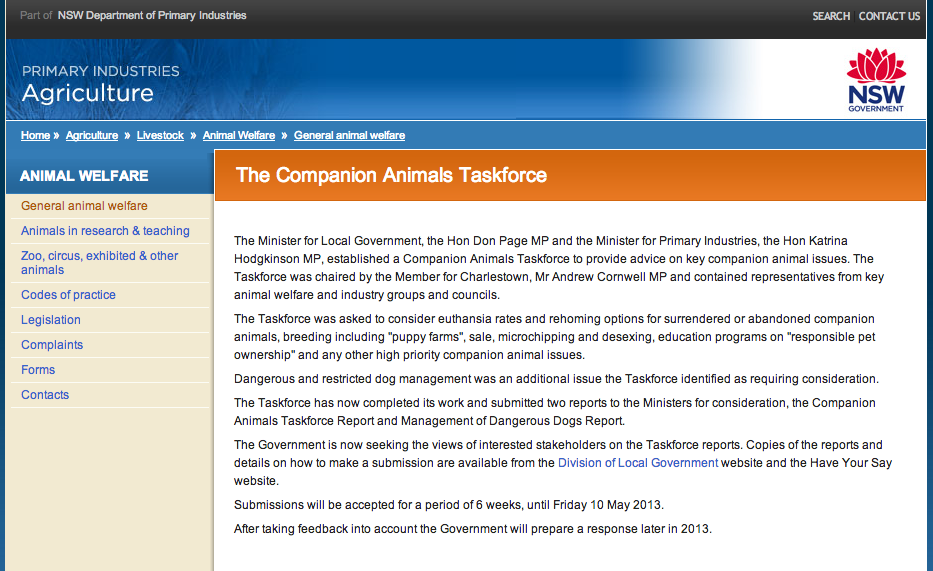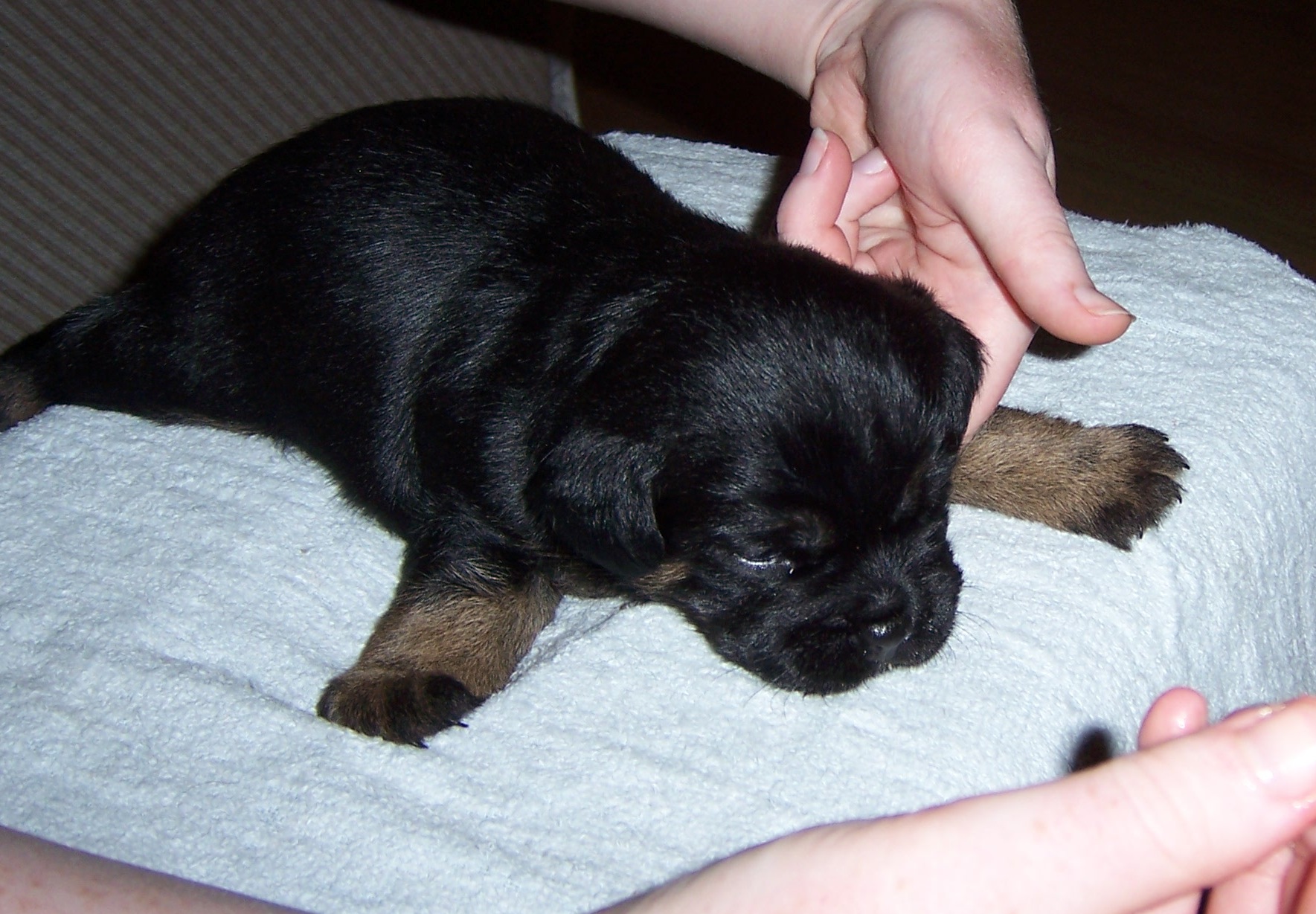Companion Animal Taskforce in NSW – Feedback
 I actually think we have pretty good legislation in regard to companion animal welfare. NSW is no exception – they have the Prevention of Cruelty to Animals Act that is simple, but effective. You can’t be cruel to animals, you have to give them food, water and shelter, you have to give them vet treatment if they need it, you can’t just abandon them, you can’t fight them, you can’t sell dying animals.
I actually think we have pretty good legislation in regard to companion animal welfare. NSW is no exception – they have the Prevention of Cruelty to Animals Act that is simple, but effective. You can’t be cruel to animals, you have to give them food, water and shelter, you have to give them vet treatment if they need it, you can’t just abandon them, you can’t fight them, you can’t sell dying animals.
Then there’s the Companion Animal Act. It requires that pets are idenitified with a microchip and collar and tag, registered, and keep those details up to date. Your dog can’t escape. You can’t have your dog offlead (except for off lead areas), and you can’t have your dogs near food areas or kid areas. Some breeds have to be muzzled (boo). Your dog can’t attack people or animals. You have to pick up your dog’s poo in public. And then what happens if you’re bad and you let this stuff happen.
All pretty simple stuff, but all stuff that makes total sense and is very easily enforceable.
But recently, across Australia, there has been justifiable concerns about the number of animals that are killed in pounds. In SA, we are still waiting for the report from the Select Committee on Companion Animal Welfare (Dogs and Cats). In NSW, they created the NSW Companion Animals Task force (brief summary of the process and players) and they had recently released a report to the Minister for Local Government and and the Minister for Primary Industries. (Oh, sorry, they went off course and made two reports, in fact, another on dangerous dog legislation.)
Basically, this is a big breeder crackdown. Somehow, the Taskforce is under the impression that breeder regulation will improve shelter euthanasia rates. However, the regulation allows backyard breeders to keep breeding with no penalty. They want their breeder’s code (which I has previously criticised) to be enforced from standards through to guidelines. They want anyone breeding to have Certificate II in Animal Studies.
The also say that a pet owner license system would “be onerous for cat and dog owners”, but it seems like this is a logical group to target when considering the shelter impound and euthanasia problem. Generally, owners surrender pets to shelters – not breeders.
Indeed, the Taskforce puts blame on breeders for the killing that pounds do. The report is dismissive of no kill and no kill legislation, but this is the only way to stop shelters from killing our pets. The Taskforce fails to acknowledge any obligation on pound facilities to ensure animals in their care aren’t euthanised.
There’s some good bits. They want breeders to be linked to animals they breed through their microchip – something I suggested way back in 2010. Rescued and desexed animals would also have cheaper registration fees – an excellent incentive to spur people to adopt. The Taskforce wants to make it easier for people to rent with pets. A few good bits in an otherwise disappointing report.
Unfortunately, you can’t do much about it but fill in a form on their website. But you may as well, it doesn’t take very long: Fill in their feedback form. NOTE: You must fill this form in quickly after you load the page, otherwise your session will ‘expire’ and you will lose all your selections. Unfun!
At the end of the form, there’s a section where you can submit less than 2000 characters. I chose to focus on the most prominent issues in this field, as obviously space was limited!
This report neglects to note that animal shelters are where animal euthanasia actually takes place. Considering this, implementing legislation that obligates shelters to undertake best practice may be beneficial in reducing euthanasia rates. This could include mandated strategies to increase reclaims, “Oreo’s Law”, or mandating minimum times for animals to be available for adoption.
When animals are reclaimed, this means they are not at risk of being euthanised. Shelters should be required to post impounded animal photos online, and there be a required process in using microchip information. Furthermore, they should be open at convenient times (for example, 8am-8pm) so working people can reclaim their pets.
“Oreo’s Law” would prevent shelters euthanizing animals where they have rescue group alternatives. In other words, pounds would only be able to destroy animals when it is really ‘the last option’.
Additionally, companion animal welfare would benefit if facilities were obligated to have animals available for adoption for a minimum period. This means that ever animal is given a minimal period to be removed from the facility by another party, and so escape euthanasia.
If we were to determine that breeder-licensing scheme was in the best interest of animal welfare, then the code of practice’s standards and guidelines are not. The code practically obligates animals to be raised in sterile conditions that are not conducive to the psychological interests of animals. This is particularly true of puppies, which have a critical socialisation window where they are required to interact with a range of new stimuli to be well-adjusted adult dogs. Ironically, ‘dangerous dogs’ are often dogs with inadequate socialisation experiences, which is what the code of practice practically obligates breeders to abide by. Any breeder code needs to focus on breeders’ producing pets that are physically and psychologically sound, which is clearly lacking in the current code.
Obviously, there is a lot more that could be set, but space is paramount, and so focussing on the critical issues is most important.
We can only hope that all recommendations, particularly regarding the breeder code, don’t get through. It’s up to us to provide sensible feedback to inform their decisions. Lets hope that logic wins out.
Further Reading:
SavingPets has written on the Companion Animals Taskforce:
Same, Same & Not at All Different – on the Taskforce’s willingness for pounds to continue their killing
RSPCA NSW Announces Support for Companion Animals Task Force – on the unsurprising reaction from RSPCA
And what I have written on companion animal welfare legislation in the past:
Clean and Kenneled: The Future of Dog Breeding – on how the breeder code in NSW puts puppies in kennel environments
What is the Answer? (To puppy farms) – on microchipping being linked to breeders
My submission to the Select Committee on Companion Animals






